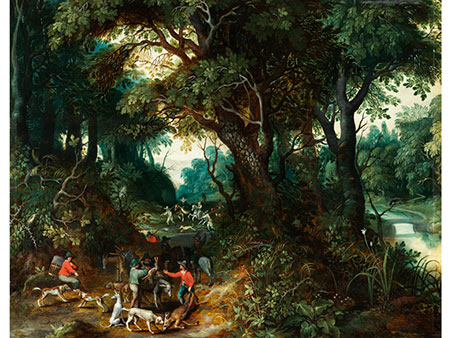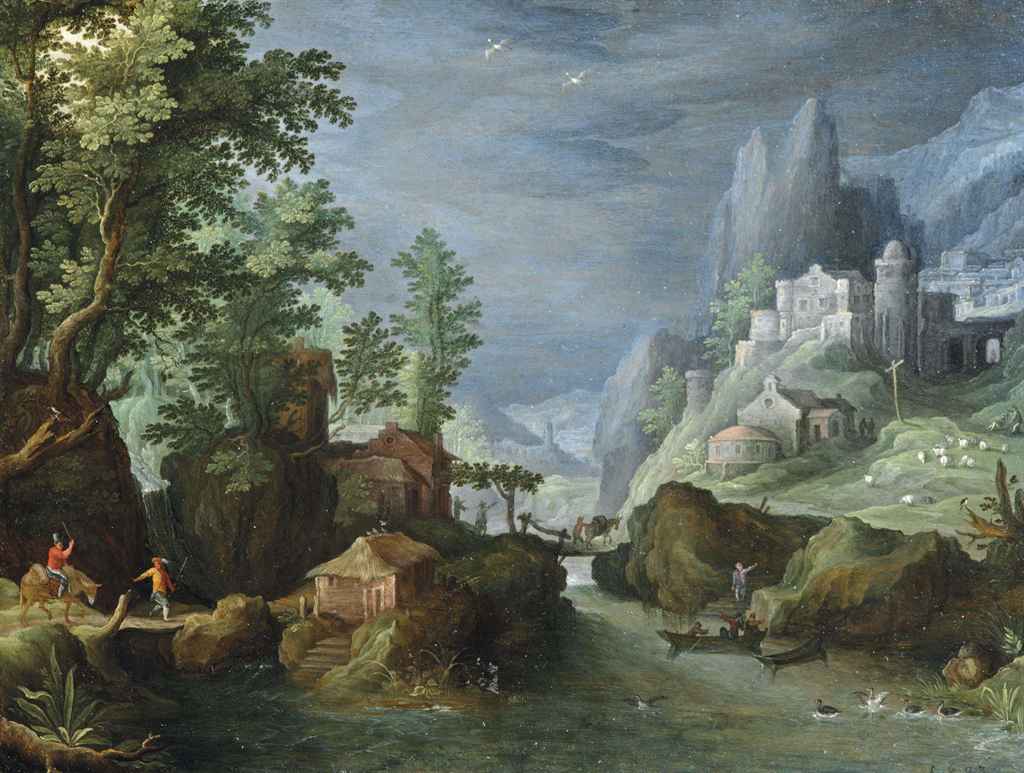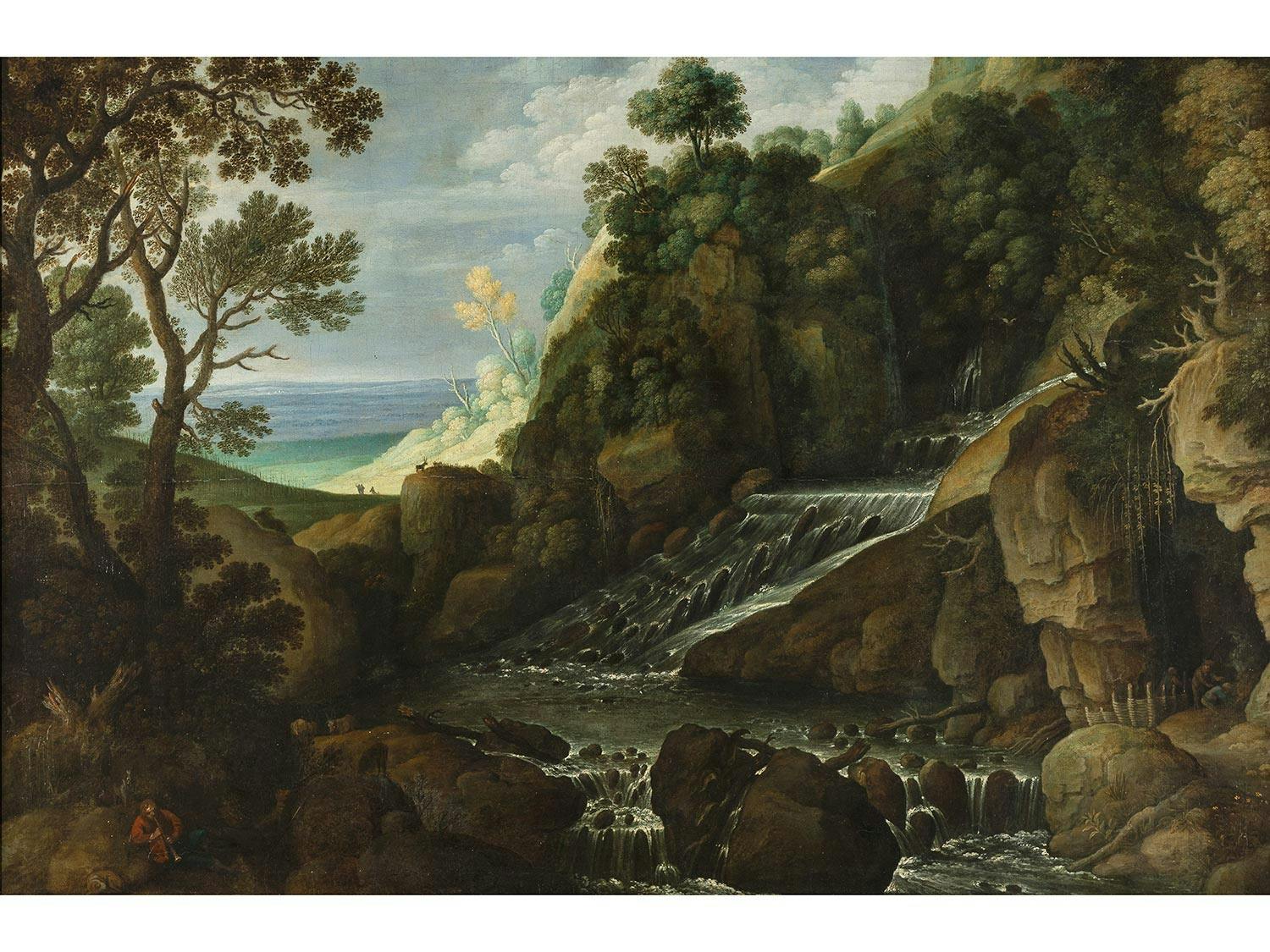Details
PAUL BRIL (BREDA 1553/1554-1626 ROME)
Le Christ sur le chemin d'Emmaüs
huile sur toile
118,5 x 171 cm. (362⁄3 x 671⁄3 in.)
Provenance
Collection du chevalier Jacques de Ghellinck.
Galerie Arthur de Heuvel et Pieter de Boer, Bruxelles et Amsterdam, vers 1960-1965.
Vente anonyme, Sotheby's, Londres, 28 octobre 1987, lot 124.
Galerie d'Art Saint-Honoré, Paris, vers 1989-1993.
Collection particulière, Suisse.Literature
G. T. Faggin, 'Per Paolo Bril', Paragone, juillet 1965, 16e année, 185/5, p. 31, n°13.
P. Eikemeier, Deutsche und Niederlandische Malerei zwischen Renaisance und Barok, Munich, 1973, p. 15.
Y. Thiery, Les peintres flamands de paysage au XVIIe siècle. Des précurseurs à Rubens, Bruxelles, 1987, pp. 101-102, reproduit en noir et blanc p. 102.
A. Berger, Die Tafelgemälde Paul Brils, coll. Kunstgeschichte, Münster-Hambourg, 1993, 12, p. 88, sous la note 85.
F. Cappelletti, Paul Bril e la pittura di paesaggio a Roma 1580-1630, Rome, 2006, p. 262, n°85, reproduit en noir et blanc p. 262.Exhibited
Londres, Victoria & Albert Museum, Third International Art Treasures Exhibition, 2 mars-29 avril 1962, n°4.
Bruxelles, Galerie Arthur de Heuvel, Catalogue de Tableaux Anciens, 1965, n°9.
Paris, Galerie d'Art St Honoré, Les temps des Brueghel. Pierre Brueghel le jeune chroniqueur de son temps, 1990-1991, n°10.Post Lot Text
PAUL BRIL, CHRIST ON THE WAY TO EMMAUS, OIL ON CANVAS
The Flemish-Roman landscape painter Paulus Bril (1553/1554-1626) was born in the city of Breda in 1553 or 1554. At the age of fourteen he supported himself by painting landscapes on harpsichords. Around twenty years of age he travelled to Lyon where he worked for a few years. He is recorded in Rome in October 1582 working alongside his elder brother Matthijs in the Vatican. Paul Bril died in 1626, leaving a large oeuvre of frescoes, etchings, drawings and cabinet pictures. He had an enormous influence on later landscape painters and is rightly considered the most important predecessor of Claude Lorrain (1604/1605-1682).
The present painting by Paulus Bril, executed on a large canvas, became known in 1962 when it was on display in the Victoria and Albert Museum in London. At the time, the composition was known through two much smaller works by the master painted on copper support. One version on the metal support (28,5 x 39,5 cm.) is signed and dated ‘Pa Brilli 1602’. It is preserved in the Glasgow Art Gallery as part of the Mc Lellan Bequest. The second related copper (26 x 24 cm.) is on display in the Alte Pinacothek in Munich and is signed by the master ‘Pa Bril Roma 1603’. The general composition and several details are similar in all these works. However, a significant difference is the position of the figure of Christ and his two fellowmen. The Glasgow painting shows them in the right hand corner, while in the Munich version they are placed more towards the center and much deeper in the landscape. In the present canvas they are positioned far in the lower right corner. The comparison of seize and support of the works in Glasgow and Munich with the present painting exemplifies a general development in Bril´s easel paintings. Shortly after 1600 Bril´s easel paintings become in general larger and often executed on canvas instead of on copper. No authentic painting by Paulus Bril on wooden support is extant. A date in or shortly after 1603 is feasible for the present painting.
A drawing in the Cabinet des dessins du Musée du Louvre shows a related composition (see L. Wood Ruby, Paul Bril The drawings, Turnhout, 1999, n°43, fig. 45). The drawing is strongly related in composition, but it can´t be considered as preparatory to the several other works in oil. The sheet in the Louvre is obviously an independent work of art and played no role in the creative process. We might assume that the three paintings and the drawing are based on a lost preparatory drawing. In all works based on this design the high tower of the citadel on top of the mountain is pivotal in the composition.
The encounter of Christ with his two disciples on the road to Emmaus, as accounted in the Gospel of Luke, was a popular theme in 16th and 17th century art. After the meeting on the road, the protagonists had their supper at Emmaus. The subject of the meeting on the road and the subsequent supper inspired a variety of artists, among them Titian (circa 1588/1490-1576), Pieter Bruegel the Elder (c. 1525/1530-1569), Rembrandt (1606-1669) and Velázquez (1599-1660).
The above observations concerning the present Christ on the way to Emmaus are based on first hand inspection, an Ekta-chrome as well as recent digital images.
We would like to thank Drs. Luuk Pijl for writing the above catalogue note.Special notice
This item will be transferred to an offsite warehouse after the sale. Please refer to department for information about storage charges and collection
details.
These lots have been imported from outside the EU for sale and placed under the Temporary Admission regime.
Import VAT is payable at 5,5% on the hammer price. VAT at 20% will be added to the buyer’s premium but will not be shown separately
on our invoice.
-
Details
PAUL BRIL (BREDA 1553/1554-1626 ROME)
Le Christ sur le chemin d'Emmaüs
huile sur toile
118,5 x 171 cm. (362⁄3 x 671⁄3 in.)
Provenance
Collection du chevalier Jacques de Ghellinck.
Galerie Arthur de Heuvel et Pieter de Boer, Bruxelles et Amsterdam, vers 1960-1965.
Vente anonyme, Sotheby's, Londres, 28 octobre 1987, lot 124.
Galerie d'Art Saint-Honoré, Paris, vers 1989-1993.
Collection particulière, Suisse.Literature
G. T. Faggin, 'Per Paolo Bril', Paragone, juillet 1965, 16e année, 185/5, p. 31, n°13.
P. Eikemeier, Deutsche und Niederlandische Malerei zwischen Renaisance und Barok, Munich, 1973, p. 15.
Y. Thiery, Les peintres flamands de paysage au XVIIe siècle. Des précurseurs à Rubens, Bruxelles, 1987, pp. 101-102, reproduit en noir et blanc p. 102.
A. Berger, Die Tafelgemälde Paul Brils, coll. Kunstgeschichte, Münster-Hambourg, 1993, 12, p. 88, sous la note 85.
F. Cappelletti, Paul Bril e la pittura di paesaggio a Roma 1580-1630, Rome, 2006, p. 262, n°85, reproduit en noir et blanc p. 262.Exhibited
Londres, Victoria & Albert Museum, Third International Art Treasures Exhibition, 2 mars-29 avril 1962, n°4.
Bruxelles, Galerie Arthur de Heuvel, Catalogue de Tableaux Anciens, 1965, n°9.
Paris, Galerie d'Art St Honoré, Les temps des Brueghel. Pierre Brueghel le jeune chroniqueur de son temps, 1990-1991, n°10.Post Lot Text
PAUL BRIL, CHRIST ON THE WAY TO EMMAUS, OIL ON CANVAS
The Flemish-Roman landscape painter Paulus Bril (1553/1554-1626) was born in the city of Breda in 1553 or 1554. At the age of fourteen he supported himself by painting landscapes on harpsichords. Around twenty years of age he travelled to Lyon where he worked for a few years. He is recorded in Rome in October 1582 working alongside his elder brother Matthijs in the Vatican. Paul Bril died in 1626, leaving a large oeuvre of frescoes, etchings, drawings and cabinet pictures. He had an enormous influence on later landscape painters and is rightly considered the most important predecessor of Claude Lorrain (1604/1605-1682).
The present painting by Paulus Bril, executed on a large canvas, became known in 1962 when it was on display in the Victoria and Albert Museum in London. At the time, the composition was known through two much smaller works by the master painted on copper support. One version on the metal support (28,5 x 39,5 cm.) is signed and dated ‘Pa Brilli 1602’. It is preserved in the Glasgow Art Gallery as part of the Mc Lellan Bequest. The second related copper (26 x 24 cm.) is on display in the Alte Pinacothek in Munich and is signed by the master ‘Pa Bril Roma 1603’. The general composition and several details are similar in all these works. However, a significant difference is the position of the figure of Christ and his two fellowmen. The Glasgow painting shows them in the right hand corner, while in the Munich version they are placed more towards the center and much deeper in the landscape. In the present canvas they are positioned far in the lower right corner. The comparison of seize and support of the works in Glasgow and Munich with the present painting exemplifies a general development in Bril´s easel paintings. Shortly after 1600 Bril´s easel paintings become in general larger and often executed on canvas instead of on copper. No authentic painting by Paulus Bril on wooden support is extant. A date in or shortly after 1603 is feasible for the present painting.
A drawing in the Cabinet des dessins du Musée du Louvre shows a related composition (see L. Wood Ruby, Paul Bril The drawings, Turnhout, 1999, n°43, fig. 45). The drawing is strongly related in composition, but it can´t be considered as preparatory to the several other works in oil. The sheet in the Louvre is obviously an independent work of art and played no role in the creative process. We might assume that the three paintings and the drawing are based on a lost preparatory drawing. In all works based on this design the high tower of the citadel on top of the mountain is pivotal in the composition.
The encounter of Christ with his two disciples on the road to Emmaus, as accounted in the Gospel of Luke, was a popular theme in 16th and 17th century art. After the meeting on the road, the protagonists had their supper at Emmaus. The subject of the meeting on the road and the subsequent supper inspired a variety of artists, among them Titian (circa 1588/1490-1576), Pieter Bruegel the Elder (c. 1525/1530-1569), Rembrandt (1606-1669) and Velázquez (1599-1660).
The above observations concerning the present Christ on the way to Emmaus are based on first hand inspection, an Ekta-chrome as well as recent digital images.
We would like to thank Drs. Luuk Pijl for writing the above catalogue note.Special notice
This item will be transferred to an offsite warehouse after the sale. Please refer to department for information about storage charges and collection
details.
These lots have been imported from outside the EU for sale and placed under the Temporary Admission regime.
Import VAT is payable at 5,5% on the hammer price. VAT at 20% will be added to the buyer’s premium but will not be shown separately
on our invoice.
-
.jpg)
.jpg)
.jpg)
.jpg)
.jpg)







Try LotSearch and its premium features for 7 days - without any costs!
Be notified automatically about new items in upcoming auctions.
Create an alert